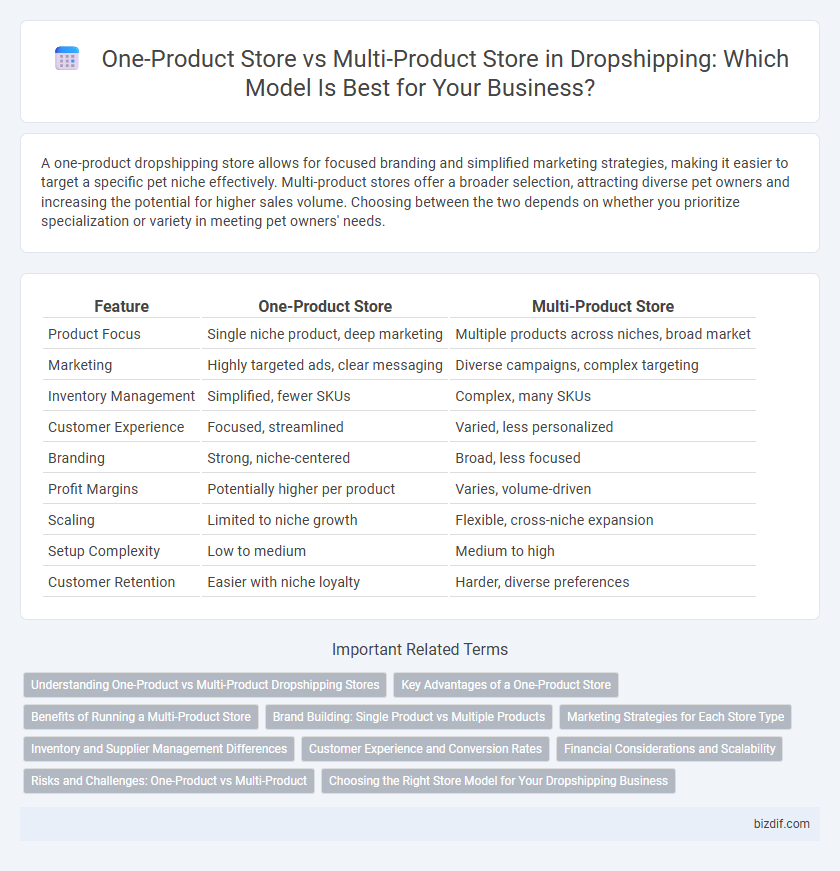A one-product dropshipping store allows for focused branding and simplified marketing strategies, making it easier to target a specific pet niche effectively. Multi-product stores offer a broader selection, attracting diverse pet owners and increasing the potential for higher sales volume. Choosing between the two depends on whether you prioritize specialization or variety in meeting pet owners' needs.
Table of Comparison
| Feature | One-Product Store | Multi-Product Store |
|---|---|---|
| Product Focus | Single niche product, deep marketing | Multiple products across niches, broad market |
| Marketing | Highly targeted ads, clear messaging | Diverse campaigns, complex targeting |
| Inventory Management | Simplified, fewer SKUs | Complex, many SKUs |
| Customer Experience | Focused, streamlined | Varied, less personalized |
| Branding | Strong, niche-centered | Broad, less focused |
| Profit Margins | Potentially higher per product | Varies, volume-driven |
| Scaling | Limited to niche growth | Flexible, cross-niche expansion |
| Setup Complexity | Low to medium | Medium to high |
| Customer Retention | Easier with niche loyalty | Harder, diverse preferences |
Understanding One-Product vs Multi-Product Dropshipping Stores
One-product dropshipping stores concentrate on a single niche item, allowing for targeted marketing and simpler inventory management, which often leads to higher conversion rates and brand loyalty. Multi-product dropshipping stores offer diverse product ranges to attract broader audiences but require complex inventory tracking and segmented marketing strategies to maintain profitability. Choosing between one-product and multi-product dropshipping stores depends on business goals, marketing capabilities, and operational resources.
Key Advantages of a One-Product Store
One-product stores excel in focused branding, allowing entrepreneurs to build a strong, recognizable identity around a single niche item, which boosts customer trust and loyalty. They enable streamlined inventory management and simplified marketing strategies, leading to reduced operational costs and higher conversion rates due to targeted advertising efforts. This concentrated approach also facilitates in-depth product expertise, enhancing customer support and increasing the potential for upselling and cross-selling complementary items.
Benefits of Running a Multi-Product Store
Running a multi-product store enhances customer retention by offering diverse product options that cater to varying preferences, increasing the likelihood of repeat purchases. It allows for better risk management by minimizing dependency on a single product's sales performance, ensuring more stable revenue streams. Additionally, diverse inventory provides opportunities for cross-selling and upselling, boosting average order value and overall profitability.
Brand Building: Single Product vs Multiple Products
A one-product store allows for concentrated brand building around a specific niche, creating a strong, recognizable identity that resonates deeply with targeted customers. In contrast, a multi-product store offers broader market reach but can dilute brand messaging, making it challenging to establish a cohesive brand image. Focusing marketing efforts on a single product enhances customer trust and loyalty, which is harder to achieve with multiple unrelated products.
Marketing Strategies for Each Store Type
One-product stores excel by concentrating marketing efforts on a single item, enabling highly targeted ad campaigns, precise audience segmentation, and tailored messaging that boosts conversion rates. Multi-product stores benefit from diversified marketing strategies such as cross-selling, upselling, and personalized recommendations to increase average order value and appeal to broader customer segments. Utilizing platform analytics and data-driven insights helps optimize ad spend and promotional tactics differently based on product range and customer behavior in each store type.
Inventory and Supplier Management Differences
One-product stores simplify inventory management by focusing on a single SKU, reducing complexity in stock tracking and supplier coordination. Multi-product stores require handling multiple SKUs, increasing the need for robust inventory systems and diverse supplier relationships to ensure product availability. Efficient supplier management in multi-product dropshipping involves negotiating terms across various niches, while one-product stores benefit from deeper partnership and streamlined communication with a single supplier.
Customer Experience and Conversion Rates
One-product stores often deliver a streamlined customer experience by focusing on a single well-curated item, which can lead to higher conversion rates through reduced decision fatigue and targeted marketing. Multi-product stores offer a broader selection, appealing to a wider audience but potentially overwhelming shoppers and diluting the personalized feel, which may lower average conversion rates. Optimizing product presentation and navigation in multi-product stores is essential to maintaining customer engagement and improving conversion metrics.
Financial Considerations and Scalability
One-product stores often require lower upfront investment and simpler inventory management, enabling faster break-even points and targeted marketing budgets. Multi-product stores typically involve higher operational costs but offer diversified revenue streams and better resilience against market fluctuations. Scalability favors multi-product stores due to their ability to expand product lines and customer segments without being limited to a single niche.
Risks and Challenges: One-Product vs Multi-Product
One-product stores face higher risks due to reliance on a single product's performance, making them vulnerable to market fluctuations and changes in consumer demand. Multi-product stores mitigate this risk by diversifying their inventory, though they encounter challenges in managing larger supply chains and increased marketing complexity. Both models require strategic planning to balance risk exposure and operational efficiency in dropshipping.
Choosing the Right Store Model for Your Dropshipping Business
Choosing the right store model for your dropshipping business depends on your niche focus and marketing strategy. One-product stores allow for targeted branding and simplified inventory management, boosting conversion rates through specialized product appeal. Multi-product stores offer broad market coverage and diversified revenue streams but require efficient inventory handling and complex marketing tactics to address varied customer interests.
One-product Store vs Multi-product Store Infographic

 bizdif.com
bizdif.com